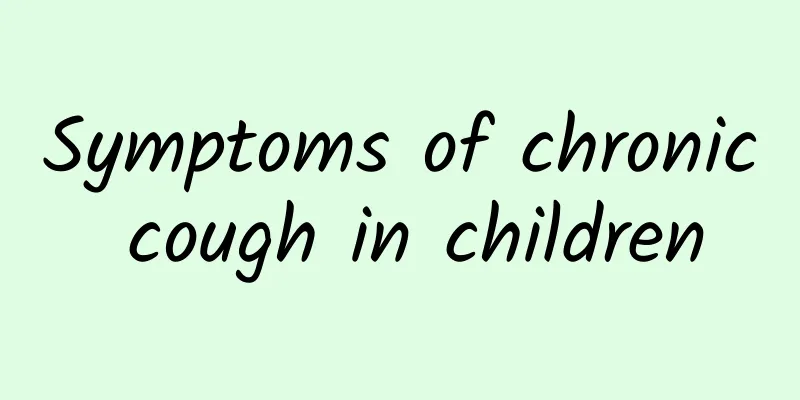Symptoms of chronic cough in children

|
Cough is a common disease in pediatrics. Generally, a cough that lasts for more than 4 weeks is called a chronic cough. Because the cough lasts for a long time, it bothers the family members. Some of them are still ineffective despite treatment. Today, I have combined clinical and related information to summarize the characteristics of the following types of coughs, hoping to help family members better understand the reasons for the baby's cough: 1. Clinical features of post-infectious cough: (1) A recent history of respiratory tract infection; (2) The cough is irritating and dry or accompanied by a small amount of white sputum; (3) No abnormalities found in chest X-ray examination; (4) Normal lung function; (5) Cough is usually self-limited; (6) Excluding other causes of chronic cough, if the cough lasts for more than 8 weeks, other causes should be considered. Analysis: Post-infectious cough occurs after respiratory tract infection, with a total course of no more than 8 weeks. It is generally treated clinically with oral Chinese medicine, and can also be combined with nebulizer inhalation treatment; but a prerequisite is to rule out cough caused by other diseases. 2. The clinical features and diagnostic clues of upper airway cough syndrome are: (1) Chronic cough with or without sputum, which is more severe in the early morning or when the body position changes, often accompanied by nasal congestion, runny nose, dry throat and foreign body sensation, repeated clearing of the throat, and a feeling of mucus adhering to the posterior pharyngeal wall. A few children complain of headache, dizziness, low fever, etc. (2) Examination of the sinus area may reveal tenderness, yellowish-white secretions may be seen flowing out of the sinus openings, and the follicles on the posterior pharyngeal wall may be significantly proliferated, presenting a cobblestone-like appearance. Sometimes, mucus-like material may be seen attached to the posterior pharyngeal wall. (3) Caused by sinusitis, corresponding changes can be seen on sinus plain film or CT scan. Note: This cough has a typical characteristic of being combined with sinusitis. The child has yellow nasal discharge. Older children will feel a foreign body sensation in the throat and have nasal discharge flowing down. Children generally have a lot of nasal discharge or severe nasal congestion, and cough severely at night or slightly more severely in the morning. It is particularly important to note that some children have enlarged adenoids and a face with enlarged adenoids. Cough and rhinitis should be taken care of at the same time in treatment. 3. Clinical features of cough variant asthma: (1) Cough lasts for more than 4 weeks, often occurs or worsens at night and/or early morning, and is mainly irritating; (2) There are no clinical signs of infection, or long-term antibiotic treatment is ineffective; (3) Anti-asthma drugs such as bronchodilators can relieve symptoms; (4) Exclude other causes of chronic cough; (5) Positive bronchial provocation test, etc.; Note: This type of cough tends to get worse seasonally, such as in spring or autumn and winter. It can usually be relieved by oral anti-allergic drugs, but some children have recurrent attacks. The main reason is that the child may be continuously exposed to allergens. For example, children who are allergic to dust mites or pollen need to stay away from allergic environments so that the cough can heal. 4. The clinical features and diagnostic clues of gastroesophageal reflux cough are: (1) Paroxysmal cough, sometimes severe cough, often occurring at night; (2) Symptoms often occur after eating, and feeding is difficult. Some children also experience upper abdominal or subxiphoid discomfort, burning sensation behind the sternum, chest pain, and sore throat; (3) In addition to causing coughing in infants, it can also cause bradycardia and arched back; Note: This type of cough is often related to diet. It is also more common in children with large body weight. Sudden cough at night, accompanied by symptoms such as acid reflux and stomach discomfort, can generally be relieved by restricting nighttime diet or taking some reflux-reducing drugs orally. 5. The clinical features and diagnostic clues of eosinophilic bronchitis are: (1) Chronic irritant cough; (2) normal chest X-ray; (3) normal pulmonary ventilation function and no airway hyperresponsiveness; (4) the relative percentage of eosinophils (EOS) in sputum is >3%; (5) Oral or inhaled corticosteroids are effective. Note: It is difficult to diagnose this type of cough in children, because most hospitals cannot measure the EOS% in sputum, and can only verify it through empirical treatment; if the condition recurs, bronchoscopy can also be performed to understand the EOS count in the alveolar lavage fluid; 6. The clinical features and diagnostic clues of psychogenic cough are: (1) More common in older children; (2) Coughing mainly occurs during the day and disappears when the patient concentrates on something or rests at night; (3) Often accompanied by psychological factors; (4) Not accompanied by organic diseases, and other causes of chronic cough are excluded. Note: This type of child is usually accompanied by emotional factors, such as aversion to school, quarrels with family members, and is greatly affected by the environment and mood. Treatment requires emotional regulation combined with medication and other therapies. 7. Another type of cough is throat clearing, which cannot be simply understood as a cough. The child has no signs of respiratory infection and is accompanied by blinking, shrugging, and nose twitching, which is related to tics. That’s all I have to say for now, I hope it will be helpful to you. |
>>: "Turning danger into safety": What are the common adverse reactions of chemotherapy?
Recommend
Will I get pregnant if I ejaculate outside?
Nowadays, young men and women generally like to u...
Can I use a facial mask when I am pregnant?
Women love beauty at all times. Even when they ar...
What causes women's feet to smell sour?
When it comes to smelly feet, the first thing tha...
Is it good to have stretch marks in late pregnancy?
Pregnant women will have some stretch marks on th...
Is a woman pregnant because of lower abdominal pain?
As for lower abdominal pain, in fact, if you are ...
What are the red and yellow spots on the tires? How to check the front tires before long-distance driving
Many car owners have found that there are red and...
Why does a girl have pain on the left side of her lower abdomen?
Our lower abdomen contains many very important or...
Can pregnant women drink pear juice?
Pear juice is a drink made from pear juice as the...
Why is the vulva itchy and has pimples?
Vulvar itching and pimples are mainly due to symp...
What to do if you miss your period for 20 days
Menstruation is very important for girls. It is n...
How did Fang Sijin and Xu Wenchang know each other before? The relationship between Fang Sijin and Xu Gugu
How did Fang Sijin and Xu Wenchang know each othe...
Picture of female Bartholin's gland cyst
The Bartholin's glands are located just below...
How long does it take to recover after a cervical biopsy?
Cervical biopsy is a minor surgery that involves ...
Does the black magic master like alkaline soil or acidic soil? What kind of soil should be used for black magic master seedlings?
The Black Master, a succulent drought-tolerant pl...
What causes pacifier pain?
Women's breasts are a very wonderful existenc...









